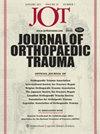A Cadaveric Study: Does Ankle Positioning Impact the Quality of Anatomic Syndesmosis Reduction?
IF 1.6
3区 医学
Q3 ORTHOPEDICS
引用次数: 0
Abstract
To compare the quality of syndesmotic reduction with the ankle in maximal dorsiflexion versus neutral plantarflexion (normal resting position). Baseline computed tomography (CT) imaging of 10 cadaveric ankle specimens from 5 donors was obtained with the ankles placed in normal resting position. Two fellowship-trained orthopaedic surgeons disrupted the syndesmosis of each ankle specimen. All ankles were then placed in neutral plantarflexion and were subsequently reduced with thumb pressure under direct visualization via an anterolateral approach and stabilized with one 0.062-inch K-wire placed from lateral to medial in a quadricortical fashion across the syndesmosis. Post-reduction CT scans were then obtained with the ankle in normal resting position. This process was repeated with the ankles placed in maximal dorsiflexion during reduction and stabilization. Post-reduction CT scans were then obtained with the ankles placed in normal resting position. All post-reduction CT scans were compared to baseline CT imaging using mixed-effects linear regression with significance set at p<0.05. Syndesmotic reduction and stabilization in maximal dorsiflexion led to increased external rotation of the fibula compared to baseline scans [13.0 degrees ± 5.4 degrees (mean ± SD) vs. 7.5 degrees ± 2.4 degrees, p=0.002]. There was a tendency towards lateral translation of the fibula with the ankle reduced in maximal dorsiflexion (3.3 mm ± 1.0 mm vs. 2.7 mm ± 0.7 mm, p=0.096). No other statistically significant differences between measurements of reduction with the ankle placed in neutral plantarflexion or maximal dorsiflexion compared to baseline were present (p> 0.05). Reducing the syndesmosis with the ankle in maximal dorsiflexion may lead to malreduction with external rotation of the fibula. There was no statistically significant difference in reduction quality with the ankle placed in neutral plantarflexion compared to baseline. Future studies should assess the clinical implications of ankle positioning during syndesmotic fixation.尸体研究:踝关节定位是否会影响解剖楔缝缩窄的质量?
比较踝关节处于最大背屈位和中立跖屈位(正常静止位)时腓肠肌联合缩窄的质量。 对来自 5 位捐献者的 10 个尸体踝关节标本进行基线计算机断层扫描(CT)成像,并将踝关节置于正常静止位置。两名受过研究培训的骨科医生破坏了每个踝关节标本的腓骨联合。然后将所有踝关节置于中性跖屈位,随后在直视下通过前外侧入路用拇指压迫缩小踝关节,并用一根 0.062 英寸的 K 型钢丝从外侧到内侧以四角形方式穿过踝关节联合进行稳定。然后在踝关节处于正常静止位置的情况下进行还原后 CT 扫描。在还原和稳定过程中,将踝关节置于最大外展位置,重复上述过程。然后在踝关节处于正常静止位置时进行还原后 CT 扫描。使用混合效应线性回归法将所有还原后 CT 扫描与基线 CT 成像进行比较,显著性设定为 p 0.05)。 在踝关节处于最大背屈状态下减小腓骨联合可能会导致腓骨外旋时减小不良。与基线相比,踝关节处于中立跖屈位时的缩窄质量没有明显的统计学差异。未来的研究应评估巩膜固定过程中踝关节定位的临床意义。
本文章由计算机程序翻译,如有差异,请以英文原文为准。
求助全文
约1分钟内获得全文
求助全文
来源期刊

Journal of Orthopaedic Trauma
医学-运动科学
CiteScore
3.90
自引率
8.70%
发文量
396
审稿时长
3-8 weeks
期刊介绍:
Journal of Orthopaedic Trauma is devoted exclusively to the diagnosis and management of hard and soft tissue trauma, including injuries to bone, muscle, ligament, and tendons, as well as spinal cord injuries. Under the guidance of a distinguished international board of editors, the journal provides the most current information on diagnostic techniques, new and improved surgical instruments and procedures, surgical implants and prosthetic devices, bioplastics and biometals; and physical therapy and rehabilitation.
 求助内容:
求助内容: 应助结果提醒方式:
应助结果提醒方式:


